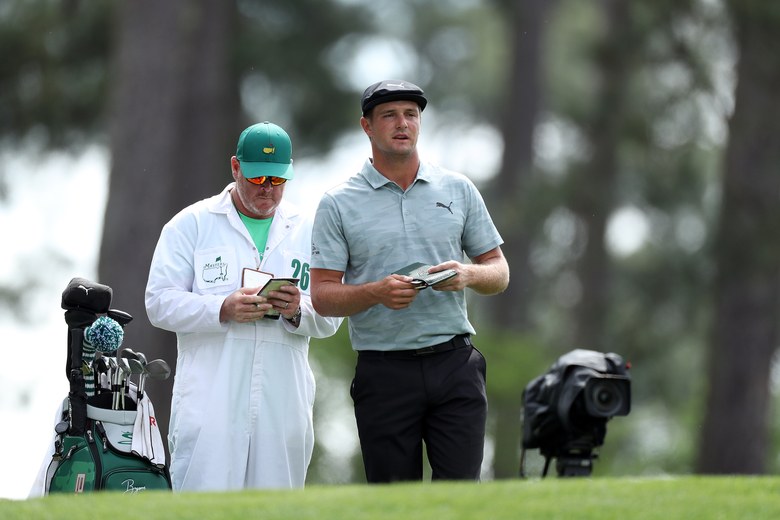AUGUSTA, GEORGIA – APRIL 12: Bryson DeChambeau of the United States stands with caddie Tim Tucker on the fourth tee during the second round of the Masters at Augusta National Golf Club on April 12, 2019 in Augusta, Georgia. (Photo by David Cannon/Getty Images)
By Dave Kindred
AUGUSTA, Ga.— On the ninth hole at the Masters on Friday, Bryson DeChambeau faced what appeared to be a simple shot for a professional golfer of his proven ability. At age 25, he has won five times on the PGA Tour. Off a downhill lie to that elevated green, he need to spin a 40-yard pitch shot to the flag.
Instead, he hit a rocket that came to rest behind the green
Oh, the misery.
Some men would have explained, “#$%#!”
Such four-letter analysis would come naturally for a player near the lead in a tournament he dearly wants to win.
Not all men, however, are Bryson DeChambeau.
I pause to say that appreciation of DeChambeau is a learned skill. Yes, we know he can play. We know he has this thing about all his clubs being the same length, though damned if we know why. Before every putt, especially the longish ones, we have seen him in deep, deep, cartographic, scientific conversation with himself, asking, “Have I read this putt from every possible angle looking for every possible imperfection in the green that might cause my putt to roll one-quarter of an inch left of my chosen line at my chosen speed, depending on the current atmospheric pressure divided by the Dow Jones number at closing?”
It’s enough to make a witness to cry out, ”Bry, baby! Little ball, big hole! PUTT!”
No four-letter analyses for DeChambeau, who said of that little misplayed shot . . .
“Hit a little 40-yard shot relative to what I do on the range all day long, accounting for a 5-, 6-, 7-degree upslope, trying to hit it 40 yards and it shoots over the green and like 60 yards, like 55 yards. I don’t get it .”
It was “most disappointing and frustrating….what happened there (hold on, here we go!) was that I didn’t catch the spin rate. I caught a lower spin rate with a lower trajectory and it just flew right over the green and just kept ascending.”
Or, in fewer letters, “#$%#!”
The old pro turned TV announcer, Gary McCord, long ago articulated a theory he called GOLF, an acronym for Genetic Overflow of Living Fluids. He believed that if you play enough golf and interact often enough wth demons, your brain melts. And when you lean over putts, it seeps out your nose. McCord’s advice: quit thinking, it fries your brain.
Which takes us from the DeChambeau extreme to another of the current stars atop the Masters leader board, a man who professes to do no thinking at all: Brooks Koepka.
After his first-round 66, Koepka was asked, “What’s going through your mind” in an hour when he made four straight birdies on the back nine.
“Absolutely nothing,” he said.
Somewhere, I think, Bryson DeChambeau screams.
Koepka went on. “I don’t want to say you kind of black out, but you just kind of – you’re not really thinking about anything. . . . you see the ball, you kind of see your shot, and then whatever you see and just pull the trigger and go.”
Here, DeChambeau throws himself into traffic.
“You’re not thinking about anything. You’re not thinking about missing. You’re not thinking about trouble. … My mind goes blank.”
I asked the English star, Ian Poulter, which methodology was the most effective for a professional golfer, the obsessive-compulsive practiced by DeChambeau or the let-it-happen practiced by Koepka.
Poulter stared at me, wide-eyed as if he’d been asked a question that would cause night horrors. Finally, he said, “I have no idea,” and as he hustled away he drew circles at his temple while calling back over a shoulder, “I don’t even want to think about it.”









